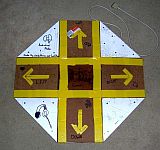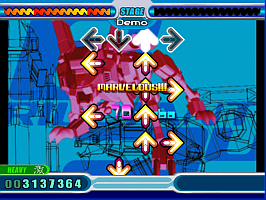
Thomas Tilley
[ Home ] [ Publications ] [ Resume ] [ Family ] [ Projects ] [ The Others ] [ Sitemap ]

[ Home ] [ Publications ] [ Resume ] [ Family ] [ Projects ] [ The Others ] [ Sitemap ]
 This is not quite the
world's crustiest Dance Dance Revolution (DDR) dance mat but it's up there (down there?) with
them. This mat was made out of scavenged wood and parts and if you
exclude the joypad (which we already had in our possession) it cost a
total of $8.00 for the wood screws and some duct-tape.
This is not quite the
world's crustiest Dance Dance Revolution (DDR) dance mat but it's up there (down there?) with
them. This mat was made out of scavenged wood and parts and if you
exclude the joypad (which we already had in our possession) it cost a
total of $8.00 for the wood screws and some duct-tape.
Back in the days when we still relied on a 56k dial-up connection we were fortunate enough to house-sit for some friends over Christmas. They had blitzing cable modem which we made good use of and after seeing a link in this Slashdot post I decided to download StepMania.
On the web you can find plans for all sorts of cool DIY dance
mats/pads including
metal pads,
plastic pads,
capacitive pads, and
even the LASER
powered LASER
Dance Matrix "mat" along with many commercial pads which range
from the cheap to the deluxe. In a throwback to my initial experince
with the game you can also now get a USB powered
mat for your fingers
although it's actually a stand alone repeat the pattern style game
like Simon.
We still had some free wood left over from
our hovercraft project and
a Thrustmaster
Firestorm Digital 3 joypad so I decided to build a wooden dance
mat.
The four direction pads on the arcade machines are 280mm (11")
squares and I decided to use a sandwich like construction with 3 layers:
I had one piece of white chipboard which was large enough for a square
base and one slightly smaller piece of black chipboard which could be
cut and moved around to fill in the middle layer. Unfortunately, I
only had some smaller pieces
of masonite for
the top layer with enough wood for five squares and not the nine I needed (the 4 dance pads plus five fixed squares).
Hmmm. It was then that I remebered that if you are ever in trouble
and you have nowhere else to turn then you can always rely on
geometry. Rather than making a square mat I decide to use an octagon
instead. By cutting the four corner pieces in half I could re-use the
cut-off pieces in the top layer to act as my four fixed corner guides.
Along with the five pieces of masonite I now had enough wood for the
top layer. The middle layer was already smaller than the base layer and needed
to match its octagonal shape. I cut the middle layer into four
sections which formed a cross shaped channel when the pieces were
spread out to align with the edges of the base. This made a
convenient place to run wiring that would then be concealed beneath
the fixed center square and corner pieces. It really didn't have to
be this complex but the mat was made on a budget and I wanted to
re-use materials that I already had. I scaveneged four tactile (tact) switches from the control panel of
an old vcr to place under each of the four direction pads. As it
serendipitously turned out the square body of the switches was the
same height as the board used for the middle layer. By drilling a hole
for each of the switches only the button protruded and the body of the
switch was protected by the board. As a result they could take a
serious pounding without being damaged. The switches were wired using flexible flat ribbon cable - which
was also scavenged - from an old dot matrix printer. One end of the
cable was split into four strips and folded to run underneath the
middle layer to each of the switches while the the other end was wired
to an old 25-pin parallel printer cable. Two pieces of pink camp mat
foam were duct taped on either side of each switch so the weight of
the direction pads didn't depress the switch and to give the pad some
bounce. This compressed nicely when you stepped on the pad so that
the switch was depressed. The picture below right shows the area
beneath the right-hand side pad with the red arrow indicating the
position of the tact switch.
With the switches mounted the fixed centre square and the four
corner triangles were then mounted and held in place with wood screws.
These acted as guides that allowed the direction pads to move up and
down but restricted their horizontal movement. The direction pads
themselves were held in place with tasteful yellow duct tape which was
also used to make the arrows on each pad. My kids then added some
custom artwork and the completed pad can be seen in the picture
below right. At this point I faced that classic problem: having built something
cool, how do I connect it to a computer? Although I only needed 4 buttons for the dance mat I decided to
wire all of the joypad's connections to the D-SUB connector. The
joypad used a common connection for all of the buttons and the
direction pad requiring a total of 13 pins on the connector: 8 for the
buttons, 4 for the direction pad and one for the common. There were
only a few solder pads that could be wired without interfering with
the normal operation of the buttons so for most of the connections I
carefully scratched the green coating off to reveal the copper and
soldered the wire to the track. You can find some more hints and
thoughts on hacking different types of controllers
here.
I initially wired the DB-25 connector so that the 4 direction pads on
the mat were mapped to up, down, left and right on the
joypad. Unfortunately I'd failed to think through the fact that most
joystick drivers don't allow you to press up AND down or left AND
right at the same time. The mat worked great for single steps but any
combos involving arrows in opposite directions didn't work. This can
also be a potential problem with PS2 to USB converters which some
people use to connect PlayStation dance mats to the PC. You can find
a list
of compatible
adaptors
and creative
workarounds on the StepMania website.
After some quick resoldering to remap the direction pads to 4
buttons our $8.00 wooden dance mat was up and running. We also used
two of the buttons on the joystick for "Start" and "Back". Here's a
picture of my daughter stomping to the beat on the finished mat.
You may also be interested in reading about some of my other projects:
 It was some months later that I rediscovered the download on my
laptop and decided to install the game. Stepmania is an open
source DDR-style
music and rhythm game. After downloading some step songs and
playing it on the keyboard I realised that I just had to build a mat
to play the game as nature intended - using my feet.
It was some months later that I rediscovered the download on my
laptop and decided to install the game. Stepmania is an open
source DDR-style
music and rhythm game. After downloading some step songs and
playing it on the keyboard I realised that I just had to build a mat
to play the game as nature intended - using my feet.

Joystick Hacking
StepMania was able to accept joystick input and so I decided to hack
my Thrustmaster USB joypad and use it to connect the dance pad to the
computer. I still wanted to be able to use the joypad so I placed a
female 25 pin D-SUB parallel port connector underneath the joystick.
Other Projects